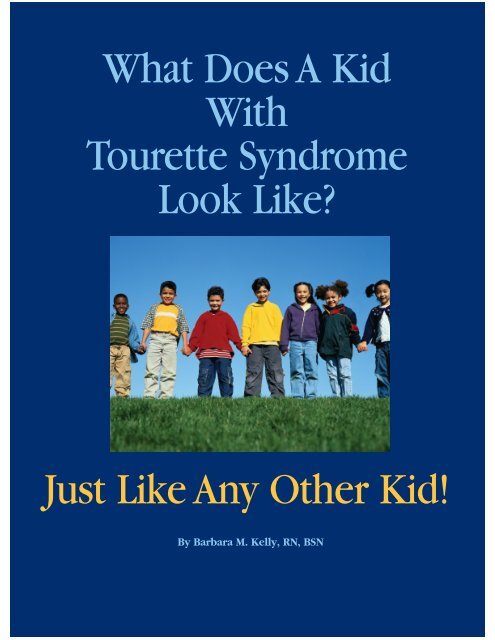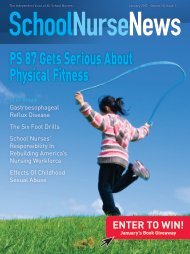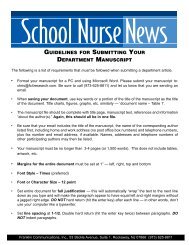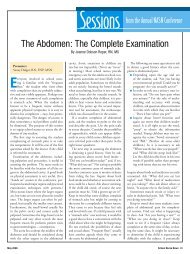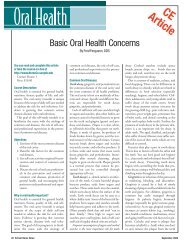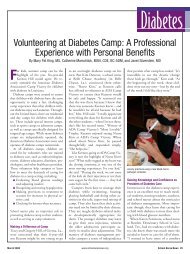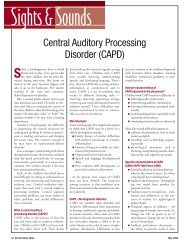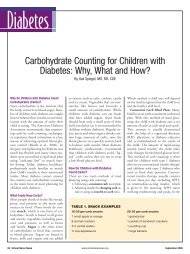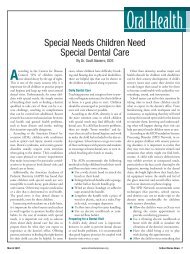What Does A Kid With Tourette Syndrome Look Like? Just Like Any ...
What Does A Kid With Tourette Syndrome Look Like? Just Like Any ...
What Does A Kid With Tourette Syndrome Look Like? Just Like Any ...
Create successful ePaper yourself
Turn your PDF publications into a flip-book with our unique Google optimized e-Paper software.
<strong>What</strong> <strong>Does</strong> A <strong>Kid</strong><br />
<strong>With</strong><br />
<strong>Tourette</strong> <strong>Syndrome</strong><br />
<strong>Look</strong> <strong>Like</strong>?<br />
<strong>Just</strong> <strong>Like</strong> <strong>Any</strong> Other <strong>Kid</strong>!<br />
By Barbara M. Kelly, RN, BSN
Many of our readers have had students in their schools diagnosed<br />
with <strong>Tourette</strong> <strong>Syndrome</strong> (TS). Caring for the medical<br />
and emotional needs of these children and teenagers is a<br />
challenge for school staff, and especially for school nurses.<br />
This issue of School Nurse News presents information about<br />
<strong>Tourette</strong> <strong>Syndrome</strong> that will assist our readers in understanding<br />
some of the complexities of this disorder. By<br />
understanding the unique characteristics of <strong>Tourette</strong><br />
<strong>Syndrome</strong> and by eliminating pre-existing mysteries, school<br />
nurses will be prepared to offer support and strategies<br />
that may help to minimize the symptoms and behaviors<br />
that can interfere with the education of these students.<br />
A Professional — and Personal — Perspective<br />
As a school nurse for over a dozen years, I have known thousands of children.<br />
I would like to tell you about three whom I know particularly well.<br />
Case 1<br />
D— was a middle child who was well liked by his schoolmates but struggled academically and<br />
seemed unhappy. He regaled his siblings and classmates with his mimicry, animal noises and<br />
facial and postural contortions. He often rode his bike at breakneck speed, yelling, “<strong>Look</strong>, no<br />
hands!” Not an unusual feat except that he was standing on the seat! D— began to falter academically<br />
at the end of first grade. His teacher noted that he had difficulty remembering what<br />
he had seen or heard and that he cried almost daily. He often became involved in physical altercations<br />
both at home and at school. He would kick people in the shins without provocation and<br />
then tearfully state that he “couldn’t help it.” He frequently had crying spells and stated that he<br />
“could not stop.” D—’s pediatrician gave him a clean bill of health and prescribed an antihistamine<br />
for environmental allergy symptoms (sniffling and throat clearing secondary to postnasal<br />
drip). In June, his teacher noted constant blinking; his school vision screening was normal. The<br />
boy’s mother felt that his eyes were probably irritated from the chlorine in the pool. That summer,<br />
D— became increasingly withdrawn and irritable. He could often be heard in his room<br />
making “monkey sounds” and refused to swim or play outdoors with his friends or siblings. He<br />
stated that the sun was “too bright,” the water in the pool “too cold” and the air “too hot.” He<br />
began changing his clothes several times a day because they “didn’t feel right.” He often sang and<br />
November 2001 School Nurse News 35
<strong>What</strong> <strong>Does</strong> A <strong>Kid</strong> <strong>With</strong><br />
<strong>Tourette</strong> <strong>Syndrome</strong> <strong>Look</strong> <strong>Like</strong>?<br />
recited dialogue from television commercials in a singsong fashion.<br />
Frequently he had difficulty falling asleep and could be heard humming<br />
in a high-pitched manner. He chewed his fingernails until they<br />
bled and picked off the scabs, leaving large scars.<br />
As summer waned, he tearfully confided to his parents that he<br />
was having “day mares,” which he described as “hearing music and<br />
seeing things in my head that I can’t stop that scare me.” He refused<br />
to elaborate. D—’s parents became so alarmed that they asked their<br />
pediatrician for a referral to a psychiatrist and requested that the<br />
school evaluate him as well. The latter was accomplished first and<br />
“no handicapping condition” noted. Prior to seeing the psychiatrist,<br />
D— was evaluated by a pediatric neurologist, who diagnosed “probable<br />
tic disorder.” An electroencephalogram was done and noted to<br />
be normal. A complete battery of neuropsychoeducational tests was<br />
administered over several weeks. Specific learning disabilities were<br />
diagnosed. A pediatric psychiatrist was also consulted, and an extensive<br />
history was obtained from the parents and the school. This<br />
process took approximately six weeks and was carried out during the<br />
summer vacation.<br />
By late August, the team had diagnosed D— with “tic disorder,<br />
obsessive-compulsive disorder and dysthymic disorder.” Specific<br />
educational accommodations were suggested and he was referred to<br />
his school district’s Committee on Special Education with the recommendation<br />
that he be classified as Learning Disabled/Health<br />
Impaired. He was started on Tofranil 25 mg at bedtime for his<br />
depressive symptoms. The dosage was gradually increased to 125<br />
mg. Copies of the private evaluations were shared with school district<br />
personnel. D—’s parents attended several meetings with school<br />
officials to determine the most appropriate setting (least restrictive<br />
environment) for their son. He was placed in a self-contained special<br />
education second grade class at an elementary school across<br />
town with eleven other students, one teacher, and a classroom aide.<br />
The school district felt that he should be classified as “multiple<br />
handicapped” with a label of emotionally disturbed, in addition to<br />
the other labels. In the new environment, D— began to make slow<br />
progress academically. His tic symptoms continued to change over<br />
time. Despite some initial unhappiness over having to leave his<br />
friends and siblings at his neighborhood elementary school, D—<br />
made a smooth transition. An Individualized Educational Plan<br />
(IEP) was developed targeting specific academic, social and behavioral<br />
goals, and parent/teacher meetings were held every few weeks.<br />
D—’s progress was communicated daily via a notebook and phone<br />
calls home. His teacher was a special education veteran with many<br />
years of experience who was eager to learn everything possible about<br />
him. After the winter vacation, D—’s diagnosis was amended to<br />
<strong>Tourette</strong> <strong>Syndrome</strong>. His mother joined a parent support group, as<br />
well as the national chapter of the <strong>Tourette</strong> <strong>Syndrome</strong> Association,<br />
and provided literature and videos to school staff. Although D—<br />
was still experiencing difficulties, the family was relieved to know<br />
that his symptoms were attributable to a disorder which was well<br />
recognized — but still misunderstood.<br />
D—’s depressive symptoms improved as did his academic performance,<br />
and he returned to his home school for fourth grade with<br />
resource room support. In middle school, his tic symptoms became<br />
quite noticeable and he was started on Catapres (clonidine). Over<br />
several months the dosage was increased, but the drug proved ineffective<br />
and was discontinued. D— stated that he felt better off the<br />
medication. By ninth grade, D— had progressed academically, was<br />
no longer in need of special education services and was declassified.<br />
He played ice hockey, was inducted into the National Honor<br />
Society, and played guitar and sang in a rock band. In his senior year,<br />
he stopped taking antidepressant medication. He currently attends<br />
college in upstate New York and plans to teach elementary education.<br />
His tics are still present, but are not bothersome, and he matter-of-factly<br />
tells anyone who inquires that he has <strong>Tourette</strong><br />
<strong>Syndrome</strong>. He recently wrote to his special education teachers to<br />
thank them for their support and understanding.<br />
Case 2<br />
A— was the youngest of three children and the only girl. Although<br />
she was a tomboy, she was afraid of the dark and always insisted<br />
that her bed face the door. She had a hard time making decisions<br />
and often missed the bus because she could not decide which shoes<br />
to wear to school. Choosing a pair the night before was no help,<br />
because they never “felt right” in the morning. A— would have to<br />
check between her toes several times each day for “sock fuzz.” She<br />
daydreamed and had great difficulty mastering abstract concepts,<br />
such as time and money. In spite of memorizing her weekly spelling<br />
words and spelling them aloud at home, she failed most of her written<br />
spelling tests. Despite nightly practice, she could not seem to<br />
learn the multiplication tables, and relied heavily on her fingers or<br />
a number line. A— was unhappy about inconsequential things over<br />
which she had no control, such as the weather and the length of her<br />
hair. On several occasions she destroyed her possessions, one time<br />
pulling apart a doll and another, gouging her initials into the top of<br />
her new dresser with a nail file. She wiggled her eyebrows, flared her<br />
nostrils, and hummed. A— reported that she had a “staring problem.”<br />
She expressed a need to maintain eye contact with both people<br />
and dogs until they looked away. She said that she was afraid<br />
that “something bad would happen” if she were to avert her gaze<br />
first. A— would often pull the hair on her father’s or older brother’s<br />
legs and then sniff her fingers. She was emotionally labile, and<br />
somewhat hyperactive, often laughing, twirling and singing or tearful<br />
and sad for no apparent reason. A— was often reprimanded for<br />
making faces in class when the teacher’s back was turned, and she<br />
could not seem to stay in her seat. She hoarded useless items, such<br />
as gum wrappers, and would remake her bed many times until it<br />
was “just right.”<br />
A— was seen by a psychiatrist who diagnosed Obsessive<br />
Compulsive Disorder and <strong>Tourette</strong> <strong>Syndrome</strong> and prescribed Prozac<br />
(fluoxetine), 20 mg in the morning. It was determined that her<br />
ADD symptoms were not problematic at that time and would be<br />
monitored and treated with stimulant medication if they worsened.<br />
She was referred to a neuropsychologist to evaluate her cognitive<br />
functioning and was noted to have Attention Deficit Disorder without<br />
Hyperactivity. She received informal academic assistance three<br />
times a week and was permitted to take her spelling tests aloud or to<br />
have someone write the words as she dictated the letters. A— still<br />
had difficulty telling time, stating, “It is 5 minutes to seven thirty.”<br />
She eventually mastered the multiplication table. Although her<br />
teachers commented that her “nervousness” interfered with her concentration<br />
and ability to complete timed assignments, she func-<br />
36 School Nurse News November 2001
tioned adequately; however, she did not enjoy school. She excelled<br />
at playing the piano, had many friends and was a voracious reader.<br />
The tics persisted throughout middle school but were mild. Her<br />
obsessions and compulsions continued to interfere with her concentration<br />
and caused her great distress. She licked her eraser before<br />
correcting mistakes, causing holes in her papers. When reading, she<br />
reported that she had to coordinate her breathing with the words; if<br />
reading while eating, she would coordinate her chewing with the<br />
words. She stated that there were always “numbers or songs running<br />
through her head” which interfered with her concentration. A—’s<br />
psychiatrist increased her Prozac to 20 mg b.i.d. and her symptoms<br />
seemed to improve after several weeks. She also appeared more animated<br />
and seemed to enjoy socializing with family and friends.<br />
Although A— was an excellent student, school remained difficult<br />
for her. Staying focused and getting organized were problems.<br />
A— would impulsively start one project or assignment before completing<br />
previous ones. Timed tests were especially difficult, because<br />
all she could think about was how much time remained. She continued<br />
to struggle with mathematics, and although she worked<br />
with a tutor several times a week, she failed the Regents examination.<br />
Despite a B in global studies, she failed that Regents test as<br />
well and attended summer school. Her psychiatrist proposed a<br />
course of Ritalin and her dosage was slowly titrated to 25 mg a day<br />
in divided doses. Her tic symptoms were not markedly increased on<br />
stimulant therapy and she reported a dramatic improvement in her<br />
attention. A— reported feeling very “focused” and enjoyed her<br />
summer school classes. She did well in the courses and eagerly<br />
anticipated the start of her junior year. As her grades improved,<br />
A— was able to resume extracurricular activities she had dropped.<br />
She started volunteering as a candy striper at the local hospital on<br />
weekends and generally seemed much happier than she had been in<br />
years. A— worried that her teachers perceived her as “stupid,” and<br />
although she knew that this wasn’t the case, she expressed her frustration<br />
at doing poorly despite extra effort and assistance. However,<br />
she has completed her freshman year at a women’s college with a<br />
3.8 GPA. She sees her physician for medication management, and<br />
a psychotherapist several times a year.<br />
Case 3<br />
P— was a meticulous, bespectacled nine-year-old, the eldest of three<br />
children. He excelled in school, played piano, and loved scouting.<br />
P— frequently went to his school’s health office complaining of a<br />
stiff neck and sore feet. His mother noted that he frequently<br />
shrugged his shoulders and moved his head from side to side as<br />
though checking his glasses for a smudged or scratched lens. His<br />
toes were reddened on the plantar surfaces, but the skin was intact.<br />
P— wiggled his toes constantly, to the point that he wore holes in<br />
his socks. He stated that he “just needed to do this sometimes.” P—<br />
alarmed his scout leader several times by attempting to touch the<br />
moving bit on a power drill the group was using to build birdhouses<br />
“to see how it would feel.” On other occasions he would push the<br />
button on the garage door opener and try to run under the door<br />
before it touched him. A cautious child, these actions seemed quite<br />
out of character.<br />
P— mimicked the way the family dog sniffed. His siblings and<br />
friends initially found this hilarious but eventually became<br />
annoyed with his incessant sniffing. He also made guttural noises<br />
in his throat, which caused him to choke when eating or drinking.<br />
P— drummed with his hands on any available surface. He did this<br />
at inappropriate times, such as in the library, at church, or when a<br />
teacher was speaking. He stated that he started wiggling his toes<br />
when one of his teachers instructed him to sit on his hands to keep<br />
him from drumming. P— was referred by his pediatrician to a<br />
neurologist for evaluation of his symptoms and was diagnosed<br />
with <strong>Tourette</strong> <strong>Syndrome</strong>. He was started on Catapres (clonidine)<br />
0.1 mg t.i.d.; however, toward the end of fourth grade, P—<br />
became increasingly sad and withdrawn socially. He felt that he<br />
was focusing all of his energy on suppressing his tics at school and<br />
that because of this, he “could not relax.” When his parents<br />
bought him a drum set for his birthday, he started lessons and<br />
began to play in the school band. He seemed happiest when riding<br />
his bicycle and practicing drums.<br />
P—’s tics were a source of great anguish to him throughout<br />
high school. Although they seemed quite subtle, he reported that<br />
he felt like “a social outcast.” He continued his piano and drum<br />
lessons, practicing for hours each day. P—’s obsessions and compulsions<br />
began to consume much of his time. He would perform<br />
certain rituals in order to assure himself that misfortune would<br />
not befall family members. These included sticking needles or<br />
pins into his fingertips, scratching his arms and legs with sticks,<br />
and arranging his possessions meticulously. He would check his<br />
drum set to be sure it wasn’t out of tune numerous times each<br />
evening. P— was able to articulate to his parents and doctor that<br />
he understood intellectually that his rituals did not protect others<br />
from harm. Still, he worried that if he did not perform them, an<br />
auto accident, serious illness or catastrophe would befall them.<br />
P— was started on Anafranil (clomipramine) with the dosage<br />
gradually increased, but it proved ineffective and he became<br />
increasingly depressed. Severe acne damaged his self-esteem further,<br />
but it did respond well to a 6-month course of Accutane.<br />
During this time, P— was unable to attend school and had home<br />
tutoring. A new medication, Luvox (fluvoxamine) was begun, but<br />
his symptoms persisted. Lithium was added to potentiate the<br />
effects of Luvox and P— began to respond. As his depressive and<br />
obsessive symptoms lessened he was able to return to school and<br />
decided that he would tell people that he had had mononucleosis.<br />
His lithium levels were closely monitored. Aside from a mild<br />
hand tremor, P— suffered no adverse effects from the medication.<br />
He complained about having to explain to medical personnel<br />
that he took lithium to potentiate the effects of Luvox for<br />
<strong>Tourette</strong> <strong>Syndrome</strong>, and did not suffer from bipolar disorder. On<br />
his new medication regimen, P— successfully completed high<br />
school. Over time, his lithium dosage was tapered. He still takes<br />
150 mg of Luvox, and sees his physician every 3 months. P—<br />
graduated magna cum laude from a prestigious university. He<br />
recently toured nationally with a musical theater company and<br />
will attend graduate school in the fall.<br />
<strong>Tourette</strong> <strong>Syndrome</strong> and<br />
Its Effects on Young People<br />
In addition to having a diagnosis of <strong>Tourette</strong> <strong>Syndrome</strong>, each of<br />
the children presented in the previous cases was also diagnosed<br />
CONTINUED ON PAGE 39<br />
November 2001 School Nurse News 37
<strong>What</strong> <strong>Does</strong> A <strong>Kid</strong> <strong>With</strong><br />
<strong>Tourette</strong> <strong>Syndrome</strong> <strong>Look</strong> <strong>Like</strong>?<br />
STUDENTS DIAGNOSED WITH TOURETTE SYNDROME —<br />
WHAT SCHOOL NURSES NEED TO KNOW ABOUT THIS NEUROLOGICAL DISORDER<br />
By Linda Dychkowski, RN, MS, SNT, NCSN, Clinical Editor School Nurse News<br />
<strong>What</strong> is <strong>Tourette</strong> <strong>Syndrome</strong>?<br />
Named for Dr. George Gilles de <strong>Tourette</strong>, a French neurologist who first<br />
described this condition in 1885, <strong>Tourette</strong> <strong>Syndrome</strong> affects all ethnic<br />
groups, and both males and females. <strong>Tourette</strong> <strong>Syndrome</strong> is a neurological<br />
disorder with a strong genetic component. It is chiefly identified by<br />
tics, involuntary movements and uncontrollable vocalizations that characteristically<br />
wax and wane. A person with TS may be able to restrain tic<br />
activity temporarily (as one would try to suppress a sneeze), but eventually<br />
the tic will express itself. Tic activity lessens during states of relaxation<br />
(i.e., during sleep or while absorbed in a particular task or activity)<br />
and worsens during stressful times. The exact cause of the disorder is<br />
unknown, but it appears that genetic abnormalities adversely affect<br />
metabolism of neurotransmitters (dopamine, serotonin, and norepinephrine)<br />
in the brain. Appearing usually before the age of 18, approximately<br />
100,000 Americans have full-blown TS, with males affected three to<br />
four times as often as females.<br />
TS can present as mild to severe, with most of those identified falling<br />
into the mild range. Obtaining a diagnosis can be difficult due to the<br />
nature of the tics that come and go, can be suppressed, and may be<br />
absent during office visits. A diagnosis of TS is a clinical one, because<br />
it is the patient’s symptoms and the family history rather than specific<br />
laboratory tests that are the definitive factors. The occurrence of both<br />
motor and phonic tics for at least a year must be present before a diagnosis<br />
can be made. Although there are no specific tests for TS, neuroimaging<br />
studies such as MRI, CT, and/or EEG may be done to rule out<br />
other conditions with similar symptoms. Although TS is chronic, it is not<br />
degenerative and does not impair intelligence. While there is no cure for<br />
the disorder, patients seem to improve with maturation and in some<br />
cases complete remission occurs following adolescence; however,<br />
other disorders (depression, anxiety attacks, and antisocial behavior)<br />
that co-exist with TS may then increase in intensity and frequency.<br />
Many of those with TS exhibit symptoms of other disorders, especially<br />
specific learning disabilities, and obsessive–compulsive, attention<br />
deficit–hyperactivity, and sleep disorders. In some cases it is these<br />
other conditions, not TS, that require treatment and medication<br />
because of their interference with daily activities.<br />
<strong>What</strong> are the symptoms?<br />
The first symptom of TS is usually the appearance of facial tics, such as<br />
blinking, or nose twitching and grimaces. Other motor tics, head jerking,<br />
neck stretching, foot stamping, or body twisting and bending, may also<br />
occur. Tics may be verbal when the patient vocalizes strange sounds,<br />
words or phrases, or they may manifest themselves in behaviors such<br />
as continual throat clearing, coughing, sniffing, or grunting, as well as<br />
sounds such as yelps, barks or shouts.<br />
Tics are categorized as either simple or complex. Sudden, brief movements<br />
with a limited number of muscle groups involved are called simple<br />
tics, whereas those that are distinct, coordinated patterns of movements<br />
and involve several muscle groups are known as complex tics.<br />
Examples of simple tics are: eye blinking, shrugging, grimacing, head<br />
jerking, and yelping and sniffing. Complex tic behaviors might include:<br />
jumping, smelling objects, touching the nose, touching others, and<br />
coprolalia or echolalia (see below).<br />
Although it is rare, some patients with severe TS may exhibit self-harming<br />
actions such as head banging, and lip and cheek biting. As previously<br />
mentioned, tic activity usually waxes and wanes, in that it increases<br />
and decreases in severity and frequency, and may also change in<br />
type or location. It is not unusual for tics to disappear for weeks or<br />
months and then to reappear suddenly. Coprolalia (uttering of obscenities)<br />
and echolalia (repeating the words of others), although the bestknown<br />
symptoms, are not the most common.<br />
The Genetics of TS<br />
TS is a genetic disorder, with dominant inheritance, that can cause mild<br />
to severe symptoms among those in the same family. A higher incidence<br />
of milder tic disorders and obsessive–compulsive behaviors is found in<br />
families with a history of TS. Gender is also an important factor in the<br />
genetics of TS: “… tics are 2-3 times as likely to occur among the sons<br />
of a parent with TS. However, daughters are 2-3 times more likely than<br />
the sons to have obsessive compulsive traits without tics.” (TSA, 2000).<br />
Medication and TS<br />
The majority of individuals who have been diagnosed with TS do not<br />
take medication; however, when symptoms interfere with activities<br />
some medications can help. At this time, there is no one medication<br />
available to treat all persons with TS, but there are different medications<br />
for specific symptoms. For instance, neuroleptics such as haloperidol<br />
and pimozide may help to decrease the frequency and intensity of tic<br />
activity in some patients. These drugs are usually given in small doses<br />
and are increased gradually until a therapeutic dosage is reached. Longterm<br />
use of these medications may cause tardive dyskinesia (an involuntary<br />
movement disorder). Other side effects of these drugs include:<br />
muscular rigidity, drooling, tremor, lack of facial expression, slow movement,<br />
restlessness, fatigue, depression and anxiety, weight gain, and<br />
thinking difficulties (confusion, slow mentation).<br />
Clonidine, an antihypertensive, may also be used to treat tics. This drug<br />
appears to be more effective in decreasing motor, rather than vocal, tics.<br />
Side effects of clonidine and similar medications are: fatigue, dry mouth,<br />
irritability, dizziness, headache, and insomnia. Other drugs used to help<br />
manage tics include fluphenazine and clonazepam.<br />
Botulinum toxin A injections (BTX) have been used to treat conditions<br />
that are characterized by abnormal muscle contractions, such as motor<br />
tics. Side effects are reported as mild and transient; they include neck<br />
weakness, dysphagia, ptosis, nausea, hypophonia, fatigue and generalized<br />
weakness. Research indicates that BTX injections, in addition to<br />
being effective and well tolerated in those with TS, also provide relief of<br />
premonitory sensations that usually precede tic occurrences (Kwak et<br />
al., 2000). Additional treatments for TS include psychotherapy, relaxation<br />
techniques, and biofeedback.<br />
Tics and Group A Beta Streptococci<br />
Some time ago, a student’s parents came to see me regarding my concern<br />
that their child’s tics seemed to be worsening. The child, a boy, had<br />
diagnoses of ADHD and obsessive–compulsive disorder (OCD), and had<br />
been medicated for many years with Ritalin. The medication seemed to<br />
be helping him, but his facial tic activity was becoming more pronounced,<br />
both at school and at home. Following my observations and<br />
recommendation, his parents brought him to his pediatrician. The next<br />
day, his parents visited me and told me their physician found that the<br />
boy was experiencing a disorder that associates increased tic activity to<br />
strep throat (he had experienced several bouts of strep throat). Although<br />
I was skeptical, I listened with an open mind and immediately began to<br />
think of other students who also might be experiencing exacerbated tic<br />
activity following such infections.<br />
The condition described here, Pediatric Autoimmune Neuropsychiatric<br />
Disorders Associated with Streptococcal Infections (called PANDA),<br />
occurs when antibodies attack healthy as well as infected cells and<br />
results in inflammation in the brain’s basal ganglia, the area that controls<br />
movement and motor control (NIMH, 1999). Caused by an autoimmune<br />
response to infection, PANDA occurs typically in young children<br />
and is characterized by a sudden onset or exacerbation of symptoms<br />
(tics and obsessive–compulsive behaviors) that worsen over time.<br />
According to Dr. Susan Swedo and colleagues at the National Institutes<br />
38 School Nurse News November 2001
of Health: “… strep infections are very common and strep-triggered<br />
neuropsychiatric disorders are quite rare, so the vast majority of children<br />
with strep infections are not at risk for developing these disorders …”<br />
The NIMH reports successful treatment of PANDA with plasma exchange<br />
(PEX) and intravenous immunoglobulin (IVIG); among subjects who<br />
receive IVIG, there was a 58 percent improvement in OCD symptoms and<br />
an improvement of 70 percent among those who received PEX.<br />
Conclusion<br />
Those who know and work with young people with <strong>Tourette</strong> <strong>Syndrome</strong><br />
can only imagine what it must be like to struggle with the unpredictability<br />
of TS symptoms each and every day. When students with TS<br />
are teased by classmates, are fearful that tics will occur in view of classmates<br />
and feel isolated from them, school nurses can intervene by<br />
encouraging them to describe their frustration and together develop<br />
strategies to remedy them. School nurses can assist students in exerting<br />
some control in their lives with coping skills that address their fears<br />
and anxieties. And if further treatment is warranted, school nurses can<br />
also facilitate referrals both in and out of the school setting. Although<br />
some behaviors are involuntary and TS-related, school nurses, together<br />
with the student, parents and school staff, can work toward recognizing<br />
and managing those that are voluntary and controllable.<br />
When TS affects a student’s ability to learn, accommodations in the<br />
classroom may be needed. According to NINDS, while many of those<br />
with TS are able to function successfully in a regular classroom, “…<br />
many may have some kind of learning disability.” Some TS students, for<br />
instance, have difficulty with handwriting due to compulsive handwriting<br />
or hand and arm tics, and could benefit by the use of computers and<br />
tape recorders. Others may need to have time extended during tests.<br />
School nurses can reach out to students with TS and their families with<br />
information and support that will assist in dispelling misconceptions that<br />
affect how others view TS and the youngsters diagnosed with the syndrome.<br />
Working closely with students, teachers and families of those with<br />
<strong>Tourette</strong> <strong>Syndrome</strong>, school nurses can facilitate students’ success both<br />
in school and beyond.<br />
References<br />
Kwak, C.H., Hanna, P.A., & Jankovic, J. Botulinum toxin in the treatment<br />
of tics. Arch Neuorol, 57(8), 1190-1193, 2000.<br />
Ort, S., Scahill, L., & Lynch, K. <strong>Tourette</strong> <strong>Syndrome</strong> and the School Nurse<br />
[pamphlet]. <strong>Tourette</strong> <strong>Syndrome</strong> Association, Inc., 1994.<br />
National Institute of Mental Health, National Institutes of Health.<br />
Treatments reduce strep-triggered symptoms of OCD and tics in some<br />
children [press release]. September 30, 1999.<br />
<strong>Tourette</strong> <strong>Syndrome</strong> Association. The Genetics of <strong>Tourette</strong> <strong>Syndrome</strong> —<br />
Whom it Affects and How it Occurs in Families [pamphlet]. Bayside, NY,<br />
Feb 2000.<br />
Resources<br />
<strong>Tourette</strong> <strong>Syndrome</strong> Association, Inc.<br />
42-40 Bell Blvd.<br />
Suite 205<br />
Bayside, NY 11361-2820<br />
www.tsa.-usa.org<br />
(718) 224-2999<br />
National Institute of Mental Health (NIMH)<br />
6001 Executive Boulevard<br />
Rm. 8184, MSC 9663<br />
Bethesda, MD 20892-9663<br />
www.nimh.nih.gov<br />
(301) 443-4513<br />
National Institute on Deafness and Other Communication Disorders<br />
(NIDCD)<br />
National Institutes of Health<br />
Bldg. 31, Rm. 3C35<br />
Bethesda, MD 20892-2320<br />
www.nidcd.nih.gov<br />
(301) 496-7243<br />
The National Institute of Neurological Disorders and Stroke (NINDS)<br />
National Institutes of Health<br />
Bethesda, MD 20892<br />
NINDS is the leading supporter of research within the federal government<br />
on TS and other neurological disorders. A part of the National<br />
Institutes of Health, NINDS is responsible for supporting and conducting<br />
research on the brain and central nervous system. Contact NINDS’ Brain<br />
Resources and Information Network (BRAIN) at: P.O. Box 13050, Silver<br />
Spring, Maryland 20911, (800) 352-9424<br />
About the Author<br />
Linda Dychkowski, RN, MS, SNT, NCSN is a Health Instructional<br />
Specialist, Coordinated School Health & Wellness Center, Western Suffolk<br />
BOCES, Long Island, New York.<br />
Acknowledgement<br />
Thanks to Alan J. Krawitz of the National <strong>Tourette</strong> <strong>Syndrome</strong> Association<br />
for the information he contributed.<br />
with associated disorders that frequently accompany TS, such as<br />
learning difficulties, attentional problems, depression, self-injurious<br />
behaviors, and obsessive–compulsive symptoms. Often, the<br />
tics are less problematic for the child than these associated conditions<br />
are. Diagnosis and treatment must be based on a comprehensive<br />
history and ongoing evaluation of TS’s typical waxing and<br />
waning symptoms. Because <strong>Tourette</strong> <strong>Syndrome</strong> frequently causes<br />
socially inappropriate symptoms and impacts self-esteem, peer<br />
relationships, academic performance and family functioning, a<br />
trusting, supportive and collaborative relationship between home,<br />
school, physician and other service providers is most important.<br />
The children presented in this article were fortunate to have<br />
been correctly diagnosed within a few months to 2 years of the<br />
onset of their symptoms. As a result of public education campaigns<br />
and increased media coverage, TS is becoming a well-recognized<br />
condition; misconceptions still persist, though. For example,<br />
school personnel involved in these cases frequently inquired about<br />
environmental and family stressors such as divorce, marital discord,<br />
domestic violence, abuse, parental substance abuse, unreasonable<br />
parental expectations, mental illness, and psychic trauma as contributing<br />
or causative factors for the students’ symptoms. This was<br />
counterproductive and frustrating to the families, who were coping<br />
with a wide range of emotions, including sadness, anger and<br />
guilt, as would be expected when a child is diagnosed with a<br />
chronic condition. In addition, several of D—’s teachers expressed<br />
doubt that he actually had TS, because they had never heard him<br />
“swear.” The uttering of obscenities — coprolalia — is the most<br />
well known symptom of <strong>Tourette</strong> <strong>Syndrome</strong> despite the fact that<br />
it occurs fairly infrequently and is not required for diagnosis.<br />
Furthermore, the involuntary nature of the tics and the ability to<br />
suppress them are often difficult to comprehend and may be<br />
wrongly attributed to a conduct disorder, deliberate aggression, or<br />
November 2001 School Nurse News 39
<strong>What</strong> <strong>Does</strong> A <strong>Kid</strong> <strong>With</strong><br />
<strong>Tourette</strong> <strong>Syndrome</strong> <strong>Look</strong> <strong>Like</strong>?<br />
oppositional/defiant behavior. One teacher threatened to cover<br />
D—’s mouth with masking tape unless he “stopped making noises.”<br />
She stated that she had read the pamphlet on <strong>Tourette</strong><br />
<strong>Syndrome</strong> but “didn’t buy the diagnosis.” A local parent support<br />
group was invaluable in assisting the parents by providing education,<br />
peer counselors, literature and advocacy services, as well as<br />
advice on how to negotiate the maze of special educational regulations<br />
and procedures to obtain appropriate interventions for students.<br />
Once the parents were informed, they could begin to<br />
inform others about the nature of their child’s symptoms.<br />
The school nurse is in an optimal position to educate school staff,<br />
support the parents and student and monitor medication side<br />
effects. The unpredictability of the symptoms with regard to severity,<br />
duration, and physical, emotional and social consequences must<br />
be considered when working with teachers, students and families.<br />
The effort required to suppress symptoms interferes with concentration,<br />
is physically and mentally taxing, and requires constant vigilance.<br />
Medication side effects, including fatigue, GI complaints,<br />
dry mouth and cognitive blunting, further complicate matters. The<br />
continued effectiveness of medications, dosage titration and side<br />
effects must be monitored over time as symptoms wax and wane.<br />
The symptoms most troublesome to the patient are targeted when<br />
pharmacological intervention is initiated — not to eliminate symptoms,<br />
but to reduce them to more tolerable levels. The school nurse<br />
can act as a liaison between school and home and provide information<br />
and resources to school personnel in order to assist them in<br />
understanding the complexities of the disorder.<br />
Once thought to be rare, <strong>Tourette</strong> <strong>Syndrome</strong> is now estimated to<br />
affect at least 1 in every 2,500 people. Although the etiology is<br />
genetic, with vulnerability transmitted from one generation to the<br />
next, no “TS gene” has been isolated. Forms in which this vulnerability<br />
is expressed may range from full-blown TS to chronic tics<br />
and/or Obsessive Compulsive Disorder (OCD) in combination or<br />
alone, and of varying severity. Children with <strong>Tourette</strong> <strong>Syndrome</strong><br />
require ongoing evaluation and care. Physicians who specialize in<br />
treating the condition are well versed in the latest research and<br />
medications and other appropriate interventions. In major medical<br />
centers, a team approach is often utilized to coordinate care. The<br />
team usually consists of a pediatric neurologist, a psychiatrist and a<br />
psychologist. The <strong>Tourette</strong> <strong>Syndrome</strong> Association maintains a<br />
national listing of physicians who specialize in the disorder (see<br />
Resources on page 39). Because there is no definitive diagnostic<br />
test, if parents suspect that their child has <strong>Tourette</strong> <strong>Syndrome</strong>, it is<br />
helpful to suggest that they keep a diary of symptoms and bring it<br />
along when consulting with one of these providers. Obtaining a<br />
diagnosis takes time. Other disorders may have to be ruled out. As<br />
illustrated in this article, associated behaviors may coexist; there<br />
may be symptom overlap. A thorough evaluation by a team of<br />
experts will confirm or rule out <strong>Tourette</strong> <strong>Syndrome</strong> so that appropriate<br />
treatment and intervention may begin. Finding a physician<br />
with whom parents feel comfortable and to whom the child can<br />
relate is imperative. Family therapy may be recommended, and has<br />
been extremely helpful.<br />
<strong>Tourette</strong> <strong>Syndrome</strong> is not easy to live with, but it can be managed<br />
successfully. It is not progressive or fatal, and tic symptoms<br />
often diminish in early adulthood. Patience, empathy and a sense<br />
of humor are virtues that will serve parents well. Children with<br />
this disorder can and do lead happy and productive lives. <strong>Tourette</strong><br />
<strong>Syndrome</strong> does not define who they are, but is rather just one<br />
facet of their identity. A combination of knowledge, excellent<br />
care, and unconditional love provides support to young people<br />
with <strong>Tourette</strong> <strong>Syndrome</strong> in their endeavors to accept and to cope<br />
with their diagnosis.<br />
ABOUT THE AUTHOR<br />
Barbara Kelly, RN, BSN received her associate degree in nursing from the Leinhard<br />
School of Nursing at Pace University in Pleasantville, New York in 1975. Since that<br />
time, she has worked in hospital, home care and school nursing. She recently earned<br />
her BSN from the Decker School of Nursing at Binghamton University and plans to<br />
begin her MSN studies this fall. Barbara is the mother of three children with <strong>Tourette</strong><br />
<strong>Syndrome</strong> and has presented numerous workshops to parents, teachers, students and<br />
nursing colleagues on coping with TS.<br />
40 School Nurse News November 2001


